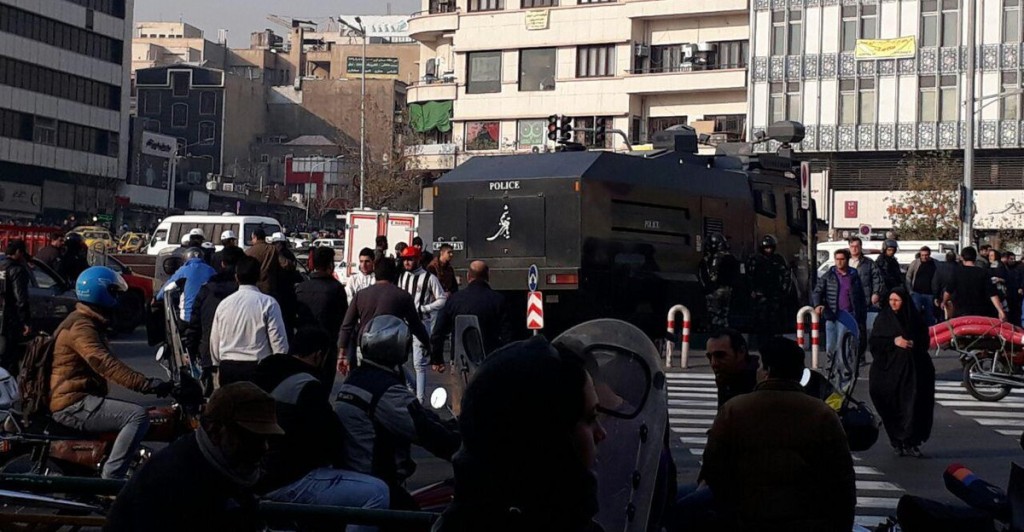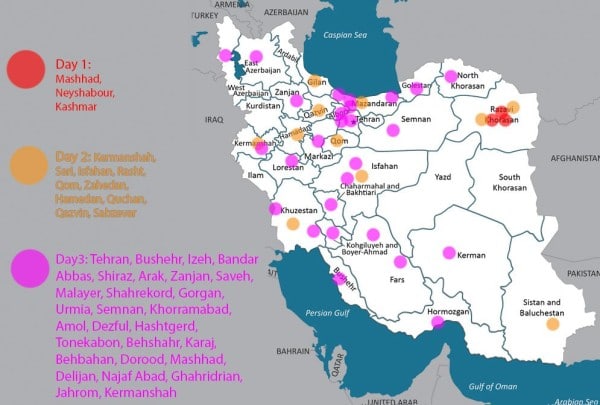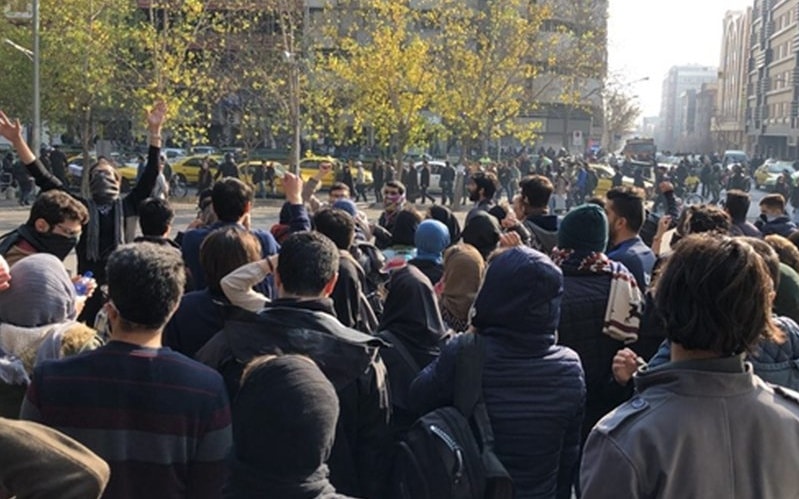UPDATE 1800 GMT: Appearing on State TV, President Rouhani has walked a line between declaring a right to protest and warning people to stay within acceptable limits in their demonstrations.
Rouhani said people must feel that they can express themselves, but he emphasized that the Government “will not tolerate those who want to destroy public buildings or riot in the streets”.
He rephrased this at another point: “The expectations and demands of the people are correct. But it is not acceptable to choose a path that creates problems or makes the enemy happy.
Analyst Siavush Randjbar-Daemi notes the vaguenes of Rouhani’s statement regarding the political and economic issues behind the demonstrations, invoking the precedent reformist President Mohammad Khatami during the 1999 Tehran protests:
Rouhani’s first reaction to recent events not dissimilar to Khatami in 1999: meek acceptance of grievances, but little in terms of practical concessions. Nothing for example on revising the budget, and its measures concerning lower income strata of society.
— Siavush Randjbar-Daemi (@AmuChelengar) December 31, 2017
Journalist Arash Karami summarizes:
I didn't notice anything ground breaking in Rouhani's speech. He accepts criticism on the economy and corruption and seems to agree with it. However, he also wants order in society (he was Secretary of Supreme National Security Council for 16 years after all).
— Arash Karami (@thekarami) December 31, 2017
UPDATE 1745 GMT: Protest in Tehran this evening:
#IranianProtests have not quieted down, we are getting videos w/delay due to interne & app disruption. #Tehran: #تطاهرات_سراسری pic.twitter.com/Wn0sLeHmM6
— Farnaz Fassihi (@farnazfassihi) December 31, 2017
People on Kargar Avenue chanting “Death to the Dictator”:
#IranProtests, 4th day, Sunday afternoon, Central Tehran: protesters chanting "Death to Dictator" pic.twitter.com/GnacjV4LDU
— Hadi Nili (@HadiNili) December 31, 2017
In Mashhad:
Day 4. Protests continue in Mashhad#IranianProtests pic.twitter.com/hg7ePrNLeR
— IranWire (@IranWireEnglish) December 31, 2017
Chabahar in southeast Iran:
#Iran: Day 4. The ppl in Chabahar, Sistan and Baluchistan province joined the anti-regime rally, chanting "Independence, Freedom, Iranian Republic". #IranProtests @BuzzFeedNews pic.twitter.com/WVzp0UeF1E
— KavehTaheri (@TaheriKaveh) December 31, 2017
UPDATE 1300 GMT: President Hassan Rouhani is expected to address the nation on State TV soon about the protests.
State TV has confirmed that Iranian authorities have blocked the messaging applications Instagram and Telegram to “maintain peace”.
Iranian television reports that “the highest security authorities” have decided to block Instagram and Telegram messaging service to protect “people’s security and peace of mind.”https://t.co/VOJa0kmYOW pic.twitter.com/1AWtedzvGh
— IranWire (@IranWireEnglish) December 31, 2017
The head of Telegram says the shutdown came after his refusal to close channels advocating peaceful protest:
Iranian authorities are blocking access to Telegram for the majority of Iranians after our public refusal to shut down https://t.co/9E4kXZYcP9 and other peacefully protesting channels.
— Pavel Durov (@durov) December 31, 2017
Tehran’s Enghelab (Revolution) Square is surrounded by anti-riot police and plainclothes agents.

A demonstration in Isfahan led by a woman assuring,”Don’t be afraid, Don’t be afraid. We are all together”:
Brave woman takes the lead in demonstration underway in Iran's Isfahan. "Don't be afraid, Don't be afraid. We are all together." pic.twitter.com/1NGE7cAsTB
— Borzou Daragahi 🖊🗒 (@borzou) December 31, 2017
Families of detained protesters gather outside Evin Prison in Tehran.
Day 4. The families of the arrested protesters have gathered outside of Evin Prison. pic.twitter.com/cLJxGvutgf
— IranWire (@IranWireEnglish) December 31, 2017
UPDATE 1030 GMT: Interior Minister Abdolreza Rahmani-Fazli has issued the latest response of the Rouhani Government to the protests.
Fazli said, “The events and incidents in recent days have caused concern, unease and unhappiness for our dear people.”
He did not address the economic or political causes of the demonstrations but emphasized that the Government, Parliament, and judiciary are determined to follow up claims to solve problems.
Most of Fazli’s statement was a denunciation of protesters, saying that they are hindering security, production, and employment. He said, “They are after causing violence and fear. Of course, such behavior will be smashed.”
🔴🎥وزیر کشور: کسانی که اقدام به تخریب اموال عمومی، بی نظمی و بی قانونی می کنند باید پاسخگوی رفتارهای خود باشند. با خشونت پراکنی و رعب و وحشت قطعا برخورد می شود. pic.twitter.com/rIHUFmnTFi
— خبرگزاری فارس (@FarsNews_Agency) December 31, 2017
ORIGINAL ENTRY: Thousands of Iranians continued protests over economic and political issues for a third day on Saturday, with the regime unable to check the discontent despite its counter-rally of support.
There were marches in almost every city, including the capital Tehran. Crowds burned photos of Iranian leaders — including the Supreme Leader and General Qassem Soleimani, the head of the elite Quds Forces — and of the paramilitary Basij while continuing chants targeting the Leader such as “Death to the Dictator” and “Shame on you, Seyyed Ali Khamenei. Let the country go.”
See Iran Video Special: Saturday’s Protests Across the Country
Iran Daily, Dec 30: Regime Shaken as 1000s Protest in Almost All Cities Across Country
The Governor’s building in Khorramabad in western Iran was reportedly set ablaze after claims that police had shot dead four protesters in Lorestan Province. Videos on social media from the town of Dorud showed two young men lying motionless on the ground, covered with blood. An Iranian journalist confirmed the death, naming the men as Hamzeh Lashni and Hossein Reshno.
Habibollah Khojastepour, the Deputy Governor of Lorestan Province, maintained, “It is clear that two protestors were killed by ISIS and foreign agents.” However, an MP from the province justified the use of force, saying police could do nothing but kill “those who crossed the boundaries”.
Here is a video from Dorud showing people carrying away a protester who was shot. A man is heard saying that the protester is dead. Source @hra_news pic.twitter.com/L1dYhXLs9l
— Maryam Nayeb Yazdi (@maryamnayebyazd) 31 December 2017
Elsewhere, most rallies were peaceful, but in Iran’s second city Mashhad a police motorcycle was set afire and footage from Rasht reportedly showed police cars alight.
Protesters have burned several police cars in #Rasht city today. #IranianProtests #Iran pic.twitter.com/XrcMX7UVWk
— Lawk Ghafuri (@LawkGhafuri) 31 December 2017
Video also showed clashes between security forces and young men in Ahwaz in southern Iran.
Protests in Ahwaz continued into the night. Source @hra_news pic.twitter.com/OUAi18410p
— Maryam Nayeb Yazdi (@maryamnayebyazd) December 30, 2017
Fars News, linked to the Revolutionary Guards, claimed only 70 people turned out in Tehran, but videos showed larger gatherings. The Islamic Students News Agency said police shut two metro stations to prevent even more protesters, and security forces used clubs to disperse people. Participants in the protest spoke of beatings, detentions, and pursuit by riot police.
Brigadier-General Esmail Kowsari, the Revolutionary Guards’ deputy security chief in Tehran, insisted the situation was under control and warned protesters would face “the nation’s iron fist”: “If people came into the streets over high prices, they should not have chanted those slogans and burned public property and cars.”
In Malayer in western Iran, crowds shout, “Down with the Dictator”, in front of a banner of the Supreme Leader:
Protesters tonight in the city of Malayer, Hamadan province, rip apart a banner with Khamenei's image while chanting: Down with the dictator. Source @hra_news pic.twitter.com/Fjy4j4PUMj
— Maryam Nayeb Yazdi (@maryamnayebyazd) December 30, 2017
In Rasht in northern Iran, crowds chant “Death to the Revolutionary Guards”:
A first in #IranianProtests #Rasht crowds chant: "Death to Revolutionary Guards."#Iran #IRGC #تظاهرات pic.twitter.com/QXo1tVfoqd
— Farnaz Fassihi (@farnazfassihi) December 30, 2017
Amazing: In Iran’s city of Rasht protestors chant against the IRGC and Basiji militia while warmly welcoming members of the security forces into their midst pic.twitter.com/xyoPDJjVLd
— Borzou Daragahi 🖊🗒 (@borzou) December 30, 2017
In Shiraz:
Protests tonight in Shiraz. The people chant: Honorable Shirazi's, join us. Source @hra_news pic.twitter.com/wFvaIFvsnv
— Maryam Nayeb Yazdi (@maryamnayebyazd) 30 December 2017
In Shahsevar in northern Iran:
Protests tonight in the city of Shahsavar, Mazandaran province. People chant: Basiji, get lost. Source @hra_news pic.twitter.com/4ERi3JV9Lk
— Maryam Nayeb Yazdi (@maryamnayebyazd) December 30, 2017
Regime Searches for a Response
The regime continued to scramble for an effective response. Its attempt for a show of support by “millions” — planned long before last week’s events but given urgency by developments — only drew about 4,000 people in central Tehran and an unknown number of people in other cities and towns. Warnings by Interior Minister Abdolreza Rahmani Fazli that people should “not participate in…illegal gatherings as they will create problems for themselves and other citizens”, and by the Revolutionary Guards that they “will not allow the country to be hurt” appeared to have no effect.
First Vice President Eshaq Jahangiri insisted on Saturday that the initial cause of the demonstrations was without basis, claiming the Iranian economy is “on the right track” despite “certain shortcomings” — although he did acknowledged that “the prices of several commodities may have seen a rise due to some incidents”. He called on those behind the demonstrations to be identified, and for all groups to work to solve Iran’s problems.
Last night authorities reportedly tried to stem the demonstrations by cutting or limiting communications. Connections to the internet wer restricted, and satellite broadcasting was jammed. The popular messaging service Telegram shut down one channel, Amad News, after authorities said it was inciting violence.
Official and semi-official media finally acknowledged the protests in their English-language outlets, but only as an opportunity to blame them on US interference. State broadcaster IRIB said on its website that it had not covered the protests because it was told by authorities that “the issue should not be reflected on state radio and television”.
Protesters in Bandar Abbas set a poster of the Supreme Leader on fire:
Protesters tonight in Bandar Abbas light a banner with Khamenei's image on fire. Source @hra_news pic.twitter.com/hEemx7utcz
— Maryam Nayeb Yazdi (@maryamnayebyazd) December 30, 2017
Khamenei’s poster is taken down in Tehran:
Protesters in the capital #Tehran took down a poster of Ayatollah Khamenei, Iran’s Supreme Leader, chanting “Death to You!" pic.twitter.com/DPwd44V1kl
— IranWire (@IranWireEnglish) December 30, 2017
A demonstration in Bojnord in northeast Iran — “Down with the dictator”:
Protest tonight in the city of Bojnord, North Khorasan province. People chant: Down with the dictator. Source @hra_news pic.twitter.com/MOXmAdaJt4
— Maryam Nayeb Yazdi (@maryamnayebyazd) December 30, 2017
A map of the spread of the protests:


